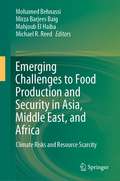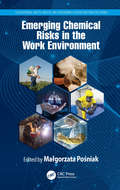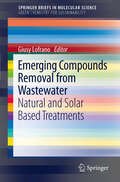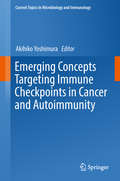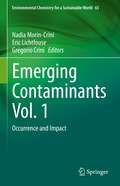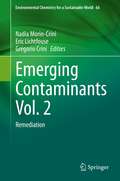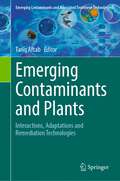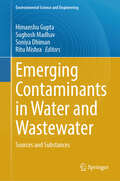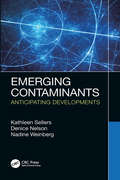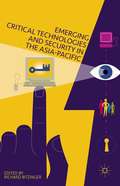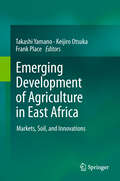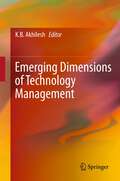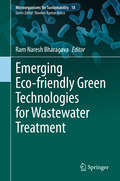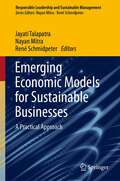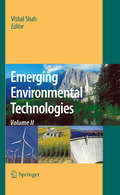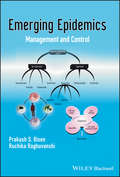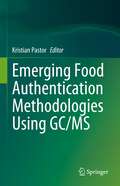- Table View
- List View
Emerging Challenges to Food Production and Security in Asia, Middle East, and Africa: Climate Risks and Resource Scarcity
by Mohamed Behnassi Mahjoub El Haiba Mirza Barjees Baig Michael R. ReedThis book, as a part of a series of CERES publications, provides a multi-regional and cross-sectoral analysis of food and water security, especially in the era of climate risks, biodiversity loss, pressure on scarce resources, especially land and water, increasing global population, and changing dietary preferences. It includes both conceptual research and empirically-based studies, which provides context-specific analyses and recommendations based on a variety of case studies from Africa, Middle East, and Asia regarding the fostering of long-term resilience of food and water security. The core approach of the volume consists of: assessing the structural drivers affecting the vulnerability of food and water security, under the persistence of current trends; identifying the best solutions and practices to enhance the climate resilience for food and water security; and fostering climate adaptation and biodiversity protection for food and water security.
Emerging Chemical Risks in the Work Environment (Occupational Safety, Health, and Ergonomics)
by Małgorzata PośniakAround the world, the production and use of nanomaterials, as well as carcinogenic, mutagenic, reprotoxic substances (CMR) and endocrine disruptors has systematically increased. The increase in production has exposed workers to hazardous substances in practically all branches of the world economy. Readers will have access to up-to-date and comprehensive knowledge on emerging risks related to nanomaterials, endocrine disruptors, reprotoxic, carcinogenic and mutagenic substances, which are related to the development of technologies and workplaces. The book will provide the tools for occupational risk assessment of chemical substances for which there are no safety levels of exposure as well as an indication of methods and measurements to protect human health and reduce chemical risks at the workplace. This book creates awareness for employers, employees and safety experts about emerging risks related to chemical agents resulting in the reduction of cancer, reproductive system diseases, cases of abnormal child development, hormonal system disorders leading to abnormal metabolism, obesity, and diabetes. Features: Comprehensive information on emerging and newly identified chemical hazards Delivers the latest data on methods and tools for identification, assessing and reducing health risks Provides practical occupational safety advice and recommendations Real life examples from measurements carried out in the workplaces "The monograph, due to the high universality of its considerations, can be addressed to a very wide audience. It is an important compendium of knowledge, which can be used by health and safety services, employers, people designing new technologies and those interested in this issue. It is a valuable and up-to-date study, among others because it uses the latest literature and quotes current legal acts.” —Sławomir Czerczak, Nofer Institute of Occupational Medicine, Poland
Emerging Compounds Removal from Wastewater
by Giusy LofranoIn the last years the release of emerging pollutants such as Endocrine Disruptors (EDCs), Pharmaceuticals and Personal Care Products (PPCPs) into the environment has raised great concern. While investigating how to treat emerging pollutants from water and wastewater, researchers have drawn attention on the implementation of more environmentally friendly technologies able to achieve high removal efficiency at low costs. Emerging Compounds Removal from Wastewater by Green Technologies: Natural and Solar Based Treatments introduces green chemistry in relation to these treatment technologies. More specifically, this volume: * Reviews the suitability of alternative adsorption processes that use natural adsorbents natural materials or agricultural waste in light of the inefficiency of conventional wastewater treatment plants; * Evaluates the potential of constructed wetlands for the removal of some categories of trace contaminant of worldwide relevance in view of their application as decentralized systems; * Highlights the promising role of a special class of oxidation techniques defined as Advanced Oxidation Processes (AOPs) supported by sunlight. This volume will be of great interest to students, technicians, and academics alike who are interested in evaluating and selecting the technologies that lead to better and more sustainable treatment of this huge class of pollutants.
Emerging Concepts Targeting Immune Checkpoints in Cancer and Autoimmunity (Current Topics in Microbiology and Immunology #410)
by Akihiko YoshimuraThis volume reviews the current state of research on immune checkpoints and offers novel concepts. It discusses the two most important immune checkpoints: T lymphocyte-associated antigen-4 (CTLA-4) and programmed cell death-1 (PD-1). It shows that antagonistic antibodies against these two molecules are highly effective in the treatment of various cancers and that PD-1 and CTLA-4 have been linked to the suppression of T-cell receptor signaling and co-stimulatory molecules. Further, the volume examines other agents, a number of cells, receptors and signaling molecules, that are also involved in the regulation of T-cell activation and extends the concept of immune checkpoints to "molecules and cells that negatively regulate T-cell activation". Playing essential roles in immune homeostasis, they could offer new targets for cancer immunotherapy, and for the therapy of autoimmune diseases. Written by internationally respected scientists, this book will appeal to basic scientists, clinicians, drug development researchers, and advanced students alike.
Emerging Concepts in Endocrine Structure and Functions
by Ebtesam A. Al-SuhaimiThis book uniquely presents conceptual understanding as well as advancements in the field of endocrinology. It emphasizes the harmonization between the function and the structure of different endocrine glands in the body. The book's initial chapters introduce hormones' biological synthesis, structure, function, and signaling pathways. The subsequent chapters examine the functional relationship between hypothalamus and pituitary gland and its leading and regulating roles on other endocrine and non- endocrine organs. A separate chapter discusses the synergistic functions of adrenal glands and pineal gland in the circadian rhythm and analyze the role of corticoids in carbohydrate and mineral metabolism. Furthermore, the book addresses the role of growth hormones, prolactin, gonads regulating hormones, adrenocorticotropin, thyroid hormones, parathormone, gluco- and mineral corticoids, insulin and glucagon, Physiology of bone remodeling is presented with the role of parathyroid glands, C cells and vitamin D explaining the bone as an endocrine organ. The regulation of male and female reproductive functions is represented well. Lastly, the book reviews the novel endocrine role and metabolic aspects of adipose tissue as an endocrine tissue and its relationship to inflammatory diseases, insulin resistance and many metabolic disorders. The book introduces key parts for endocrine’s stem cell in each gland is discussed in term of its survival, proliferation, migration, homing, differentiation and its regeneration and remodeling roles.
Emerging Concepts of Tumor Exosome–Mediated Cell-Cell Communication
by Huang-Ge ZhangIn multicellular organisms, communication between cells involves secretion of proteins that bind to receptors on neighboring cells. While this has been well documented, another mode of intercellular communication has recently become the subject of increasing interest: the release of exosomes. In cancer, tumor exosomes are involved in various aspects of pathogenesis, including proliferation, immunosuppression, and metastasis. Given the ability of exosomes to export unneeded endogenous molecules from cells, these structures hold great potential as anticancer therapeutic agents. They are also being studied as prognostic markers for cancer.
Emerging Contaminants Handbook
by Ian Ross Caitlin H. Bell Margaret Gentile Erica Kalve John Horst Suthan SuthersanThe term "emerging contaminants" and its multiple variants has come to refer to unregulated compounds discovered in the environment that are also found to represent a potential threat to human and ecological receptors. Such contaminants create unique and considerable challenges as the push to address them typically outpaces the understanding of their toxicity, their need for regulation, their occurrence, and techniques for treating the environmental media they affect. With these challenges in mind, this handbook serves as a primer regarding the topic of emerging contaminants, with current and practical information to help support the goal of protection where they are encountered. Features Explores the definition, identification, and life cycle of emerging contaminants. Reviews current information on sources, toxicology, regulation, and new tools for characterization and treatment of: 1,4-Dioxane (mature in its emerging contaminant life cycle) Per- and polyfluoroalkyl substances (PFASs; a newer group of emerging contaminant) Hexavalent chromium (former emerging contaminant with evolving science) 1,2,3-Trichloropropane (progressing in its emerging contaminant life cycle) Provides thoughts on opportunities in managing emerging contaminants to help balance uncertainty, compress life cycle, and optimize outcomes.
Emerging Contaminants Vol. 1: Occurrence and Impact (Environmental Chemistry for a Sustainable World #65)
by Eric Lichtfouse Grégorio Crini Nadia Morin-CriniEmerging contaminants are chemical and biological agents for which there is growing concern about their potential health and environmental effects. The threat lies in the fact that the sources, fate and toxicology of most of these compounds have not yet been studied. Emerging contaminants, therefore, include a large number of both recently discovered and well-known compounds such as rare earth elements, viruses, bacteria, nanomaterials, microplastics, pharmaceuticals, endocrine disruptors, hormones, personal care products, cosmetics, pesticides, surfactants and industrial chemicals. Emerging contaminants have been found in many daily products, and some of them accumulate in the food chain. Correlations have been observed between aquatic pollution by emerging contaminants and discharges from wastewater treatment plants. Most actual remediation methods are not effective at removing emerging contaminants. This first volume presents comprehensive knowledge on emerging contaminants with a focus on analysis, toxicity, antibiotic resistance and human health.
Emerging Contaminants Vol. 2: Remediation (Environmental Chemistry for a Sustainable World #66)
by Eric Lichtfouse Grégorio Crini Nadia Morin-CriniEmerging contaminants are chemical and biological agents for which there is growing concern about their potential health and environmental effects. The threat lies in the fact that the sources, fate and toxicology of most of these compounds have not yet been studied. Emerging contaminants, therefore, include a large number of both recently discovered and well-known compounds such as rare earth elements, viruses, bacteria, nanomaterials, microplastics, pharmaceuticals, endocrine disruptors, hormones, personal care products, cosmetics, pesticides, surfactants and industrial chemicals. Emerging contaminants have been found in many daily products, and some of them accumulate in the food chain. Correlations have been observed between aquatic pollution by emerging contaminants and discharges from wastewater treatment plants. Most actual remediation methods are not effective at removing emerging contaminants. This second volume presents comprehensive knowledge on emerging contaminants with a focus on remediation.
Emerging Contaminants and Plants: Interactions, Adaptations and Remediation Technologies (Emerging Contaminants and Associated Treatment Technologies)
by Tariq AftabEmerging contaminants (ECs) are predominantly unregulated anthropogenic chemicals that occur in air, soil, water, food, and plant/animal tissues in trace concentrations. ECs are persistent in the environment, capable of perturbing the physiology of target receptors and, therefore, are increasingly regarded as a subject of concern. This volume aims to enhance understanding of emerging contaminants’ effects on plants and the environment and to highlight and address the need of sustainable and eco-friendly approaches in mitigating and remediating the effects of ECs. The book comprises chapters from diverse areas dealing with biotechnology, microbial technology, nanotechnology, molecular biology, remediation, and more. This volume will be useful to remediation practitioners, researchers, regulators and graduate students.
Emerging Contaminants in River Ecosystems
by Sergi Sabater Damià Barceló Mira Petrovic Arturo ElosegiThis volume offers an overview of the occurrence of emerging organiccontaminants in Mediterranean rivers and their relevance to their chemical and ecologicalquality under water scarcity. With chapters covering the effects under multiple stressconditions of pharmaceuticals, polar pesticides, personal care products, and industrialchemicals, the observations presented can be applicable to other parts of theworld where water scarcity is an issue . It is of interest to environmentalchemists, ecologists, environmental engineers, and ecotoxicologists, as well aswater managers and decision-makers.
Emerging Contaminants in Water and Wastewater: Sources and Substances (Environmental Science and Engineering)
by Himanshu Gupta Sughosh Madhav Ritu Mishra Soniya DhimanThis present book serves as a comprehensive compilation of various emerging contaminants in the ecosystem, their contamination risk as well as the applicable remediation techniques. Exploding urbanization and industrialization often combined with improved standards of living have resulted in deleterious effects on the quality of the environment. Due to rapid growth of industrialization in the past few decades, large amounts of undesirable wastes are being discharged into the environment threatening the survival of living beings on the earth. In the recent years, the problems regarding pollution have become more global, and awareness about the environmental problems is increasing continuously. Environmental awakening has led many scientists to focus on the assessment of environmental impact of various emerging contaminants. The first victims of the environmental pollution are the terrestrial plants and aquatic bodies in the vicinity of urban areas that experience heavy pollution due to industrial effluents, toxic chemicals, hospital waste, radioactive waste, industrial fumes, vehicular traffic, etc. The increasing industrialization and use of hazardous chemicals are responsible for the lack of access to clean water in many parts of the world. In view of the widespread occurrence, persistence, and harmful effects of environmental pollutants on human population, the present book is proposed. Emerging contaminants due to ubiquitous distribution, persistence, and toxic effects have necessitated the development of efficient methods for remediation of contamination. Reports appearing from time to time reveal that the number and concentration of contaminants in the environment are continuously increasing. Thus, development as well as dissemination of new and eco-friendly methods for the removal of these pollutants has become a challenging task.
Emerging Contaminants: Anticipating Developments
by Kathleen Sellers Denice K. Nelson Nadine WeinbergEmerging Contaminants: Anticipating Developments examines the factors that have led "new" environmental contaminants to emerge in the past and combines the lessons learned to anticipate potential new developments. The analyses described in this book originate in multiple disciplines: the science of toxicology; environmental law and regulation; the field of product stewardship; and the social science which explains why ideas take hold. Over a dozen case studies of contaminants that emerged as environmental issues over the last hundred years illustrate crucial points. The results of the analyses in this book support a step-by-step method to assess the potential for a contaminant to emerge, and a framework to apply those conclusions to managing site liabilities. Features: Describes an unprecedented understanding of why contaminants emerge as issues, based on a multidisciplinary analysis Makes abstract concepts tangible, basing analyses on data and illustrating key points with case studies Enables readers to anticipate and prepare to manage future challenges associated with emerging chemicals Presents an analytical framework for companies to assess and manage business risks Written for regulators, policymakers, industry professionals with responsibility for contaminated site management, as well as attorneys, and consultants, this book provides a framework for anticipating the emergence of new contaminants so that the risks–whether to human health and the environment or to a business–can be anticipated and appropriately managed.
Emerging Critical Technologies and Security in the Asia-Pacific
by Richard BitzingerThe proliferation of advanced militarily relevant technologies in the Asia-Pacific over the past few decades has been a significant, and perhaps even alarming, development. This volume addresses how such technologies may affect military capabilities and military advantage in the region.
Emerging Development of Agriculture in East Africa
by Frank Place Keijiro Otsuka Takashi YamanoEmerging Development of Agriculture in East Africa offers case studies that find promise in many new innovations. Farmers in Uganda have quickly learned the management of NERICA rice (a new upland rice variety), which is being disseminated in a limited way in the region. Also in Uganda, farmers living in more remote areas have improved access to markets due to the expansion of mobile phones. In Kenya, improved milk marketing systems have increased efficiency and led to tangible increases in the adoption of dairy production technologies. And the adoption of intensive dairy production systems in Kenya and Uganda are providing significant amounts of manure and positively impacting yields of maize and banana.
Emerging Dimensions of Technology Management
by K B AkhileshTechnology is the key driver of business. May it be airport, ICT , smart governance, manufacturing or plantations. Technology management opens up opportunities for the business and help achieve leadership positions. This collection of papers provides a glimpse of issues faced in different sectors. These papers also should inspire more researchers to expand the scope of the subject itself.
Emerging Dynamics: Science, Energy, Society and Values
by Loucas G. ChristophorouEmerging Dynamics: Science, Energy, Society and Values focuses on the impact of science, science-based technology and scientific values on present-day humanity and its future. The book advocates for a science willing to accommodate both human values and scientific facts. The four main subjects focused on throughout the text are:The overwhelming impact of modern science and science-based technology on virtually every aspect of human lifeHuman values and their significance for science and societyThe need for mutual accommodation between scientific values and the traditional values of societyThe fundamental role of energy for civilization and society.The book cuts across scientific disciplines and looks at modern civilization through the knowledge provided by the physical, chemical, biomedical and other branches of natural science. The book is unique in its holistic approach, combining knowledge acquired by deduction, reduction-induction, and experimental scientific methods with knowledge acquired through history, philosophy, the arts, faith and cultural traditions. Modern civilization’s most distinct characteristics are due to science, science-based technology and energy. The role of energy in the sustainability of civilization and the impact of biomedical science on man are especially emphasized throughout this timely book, making a case for a hopeful future based on both science and values. A science guided in its applications by human values and a value system cognizant of the facts of science and willing to accommodate them
Emerging Eco-friendly Green Technologies for Wastewater Treatment (Microorganisms for Sustainability #18)
by Ram Naresh BharagavaAs we know, rapid industrialization is a serious concern in the context of a healthy environment and public health due to the generation of huge volumes of toxic wastewater. Although various physico-chemical and biological approaches are available for the treatment of this wastewater, many of them are not effective. Now, there a number of emerging ecofriendly, cost-effective approaches utilizing microorganisms (bacterial/fungi/algae), green plants or their enzymes, and constructed wetland treatment systems in the treatment of wastewaters containing pollutants such as endocrine disrupting chemicals, toxic metals, pesticides, dyes, petroleum hydrocarbons and phenolic compounds. This book provides a much-needed, comprehensive overview of the various types of wastewater and their ecotoxicological effects on the environment, humans, animals and plants as well as various emerging and eco-friendly approaches for their treatment. It provides insights into the ecological problems and challenges in the treatment and management of wastewaters generated by various sources.
Emerging Economic Models for Sustainable Businesses: A Practical Approach (Responsible Leadership and Sustainable Management)
by René Schmidpeter Nayan Mitra Jayati TalapatraThe book discusses new and emerging economic models, that respond to 'Pulling' and 'Pushing' forces. Today we are poised at an interesting juncture, with favourable conditions making it easier to be a sustainable organization acting as a ‘Pulling’ Force and the climate crisis, rise in social-economic equities thereby ‘Pushing’ for urgent action. The book analyses economic models that look at value propositions, creation and capture with ‘People, Planet and Profit’ deeply embedded in each stage of the value chain. The contributions bring out the interplay between new standards, evaluation frameworks, technology innovation and other emerging tools to show how they create a sustainable business. For this, they lean on learnings from successful sustainable businesses. Business leaders will find that this book provides deep insights on improving their existing sustainable practices, and speeding up the transition from linear to circular, narrow stakeholder driven to community driven. For prospective entrepreneurs the book provides the nudge needed to start up a sustainable enterprise. Students and researchers can benefit from real-life examples of how sustainable transformations unfold.The book thus creates an easy guide for those willing to make the transition to sustainability, start a sustainable business and most of all, to motivate those who may not yet be convinced about the long-term sense of taking care of our people and our earth.
Emerging Electromagnetic Technologies for Brain Diseases Diagnostics, Monitoring and Therapy
by Lorenzo Crocco Irene Karanasiou Michael L James Raquel Cruz ConceiçãoThis timely book presents innovative technologies for use in the diagnosis, monitoring, and treatment of brain disease. These technologies offer exciting possibilities in the medical field owing to their low-cost, portability and safety. The authors address cerebrovascular diseases such as stroke, ischemia, haemorrhage, and vasospasm, these diseases having an ever-increasing societal relevance due to the global ageing population. The authors describe the potential of novel techniques such as microwave imaging and present innovative modalities for treatment of brain tumours using electromagnetic fields and nano-composites, as well as for monitoring brain temperature during surgery. Finally, Emerging Electromagnetic Technologies for Brain Diseases Diagnostics, Monitoring and Therapy addresses the perspectives which arise from multi-modal multi-spectral EM modalities, which make a synergic use of the different portions of the electromagnetic spectrum. This text will be of interest to readers from various different areas, given the fundamental interdisciplinarity of the subject matter. This includes researchers or practitioners in the field of electrical engineering, applied physicists, and applied mathematicians working on imaging applications for biomedical and electromagnetic technologies. Neurologists and radiologists may also find this book of interest, as may graduate students in these areas.
Emerging Energy Materials: Applications and Challenges (Series in Materials Science and Engineering)
by Sanjay J. Dhoble Govind B. Nair H. Nagabhushana Nirupama S. DhobleEmerging Energy Materials: Applications and Challenges guides the reader through materials used in progressive energy systems.It tackles their use in energy storage across solar, bio, geothermal, wind, fossil, hydrogen, nuclear, and thermal energy. Specific chapters are dedicated to energy reaping systems currently in development. This book contributes to the current literature by highlighting concerns that are frequently overlooked in energy materials textbooks. Awareness of these challenges and contemplation of possible solutions is critical for advancing the field of energy material technologies.Key features: Provides up-to-date information on the synthesis, characterization, and a range of applications using various physical and chemical methods Presents the latest advances in future energy materials and technologies subjected to specific applications Includes applied illustrations, references, and advances in order to explain the challenges and trade-offs in the field of energy material research and development Includes coverage of solar cell and photovoltaic, hydro power, nuclear energy, fuel cell, battery electrode, supercapacitor and hydrogen storage applications This book is a timely reference for researchers looking to improve their understanding of emerging energy materials, as well as postgraduate students considering a career within materials science, renewable energy and materials chemistry.
Emerging Environmental Technologies, Volume II
by Vishal ShahWhile numerous journals and books are available in the market highlighting the developments in the field of environmental technology, none of them exclusively focuses on the technologies that would be in the forefront in near to far future. Each and every article in the book is peer-reviewed and from a different sub-discipline. Because of its interdisciplinary topics on for instance air pollution and energy production, this makes it a one book for all and serves as an excellent resource for scientists, entrepreneurs, politicians and non-governmental organizations who wish to gain information on upcoming and promising technologies.
Emerging Epidemics: Management and Control
by Prakash S. Bisen Ruchika RaghuvanshiA global perspective on the management and prevention of emerging and re-emerging diseases Emerging infectious diseases are newly identified or otherwise previously unknown infections that cause public health challenges. Re-emerging infectious diseases are due to both the reappearance of and an increase in the number of infections from a disease that is known, but which had formerly caused so few infections that it was no longer considered a public health problem. The factors that cause the emergence or re-emergence of a disease are diverse. This book takes a look at the world's emerging and re-emerging diseases. It covers the diagnosis, therapy, prevention, and control of a variety of individual diseases, and examines the social and behavioral issues that could contribute to epidemics. Each chapter focuses on an individual disease and provides scientific background and social history as well as the current basics of infection, epidemiology, and control. Emerging Epidemics: Management and Control offers five topics of coverage: FUNDAMENTALS Epidemics fundamentals Disasters and epidemics Biosafety RE-EMERGING EPIDEMICS Tuberculosis Plague NEWLY EMERGING EPIDEMICS Leptospirosis Dengue Japanese Encephalitis Chikungunya Fever West Nile Virus Chandipura Virus Encephalitis Kyasanur Forest Disease Hantavirus Human, Avian, and Swine Influenza Severe Acute Respiratory Syndrome Nipah Virus Paragonimiasis Melioidosis POTENTIAL EPIDEMICS Biowarfare and bioterrorism Food contamination and food terrorism Antimicrobial resistance VECTOR CONTROL METHODS Mosquito control Other disease vectors and their control Offering an integrated, worldwide overview of the complexity of the epidemiology of infections, Emerging Epidemics will be a valuable resource for students, physicians, and scientists working in veterinary, medical, and the pharmaceutical sciences.
Emerging Fluorinated Motifs, 2 Volume Set: Synthesis, Properties and Applications
by Dominique Cahard Jun-An MaA must-have resource for all the researchers working in the organofluorine and related fields This timely two-volume set uniquely focuses on emerging fluorinated motifs beyond R-CF3 and R-F, like R-CF2H, R-OCF3, R-SCF3 and R-SF5. It also offers descriptions of the properties, synthesis, and applications of these emerging fluorinated motifs in order to help readers design new chemical entities, while providing new interest for researchers in organofluorine chemistry and new tools for those in other areas. Emerging Fluorinated Motifs: Synthesis, Properties and Applications begins with a description of carbon-linked fluorine-containing groups that include monofluoromethyl and difluoromethyl groups. It then details combinations of heteroatoms, Oxygen, Sulfur, Selenium, Nitrogen, and Phosphorus with fluorine-containing groups, outlining subsections of the most popular current motifs. Fluoroalkyl ethers, thioethers, and the recent blossoming of the SF5 unit is covered. Other chapters look at: selenium-linked fluorine-containing motifs; construction of N?CF2H, N?CF3, N?CH2CF3 motifs; and the synthesis and applications of P¿Rf-containing molecules. -Focuses on the synthesis, properties, and applications of emerging fluorinated motifs -Covers carbon-linked fluorine-containing motifs, oxygen-linked fluorine-containing motifs, sulfur-linked fluorine-containing motifs, and more -Appeals to academic and industrial researchers working in organic chemistry, medicinal chemistry, food chemistry, and materials science -Edited by world-renowned experts in organofluorine chemistry Emerging Fluorinated Motifs is intended for academic research institutes, university libraries, researchers, graduate students, postdoctors, and researchers in the chemical industry.
Emerging Food Authentication Methodologies Using GC/MS
by Kristian PastorThis edited book provides an overview of existing and emerging gas chromatography/mass spectrometry (GC/MS) based methods for the authentication and fraud detection in all major food groups and beverages. Split in four parts, the book opens with a comprehensive introduction into the GC/MS technique and a summary of relevant statistical and mathematical models for data analysis. The main parts focus on the authentication of the main food groups (cereals, dairy products, fruit, meat, etc.) and beverages (e.g., coffee, tea, wine and beer). The chapters in these sections follow a distinct structure describing the nutritional value of the product, common fraud practices, economic implications and relevant biomarkers for the authentication process, such as volatile compounds, fatty acids, amino acids, isotope ratios etc. The final chapter provides an outlook on where the methodologies and the applications may be heading for. Food fraud is serious problem that affects food industries of all kinds, which is why food authentication plays an increasingly important role. This book aims to serve as a knowledge base for all researchers in academia, regulatory laboratories and industry employing GC/MS for food analysis. Due to its comprehensive introduction and consistent structure, it can also serve as an excellent resource for students in food science, food technology, food chemistry and nutrition.
